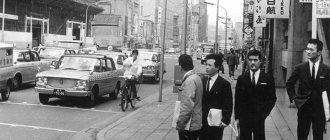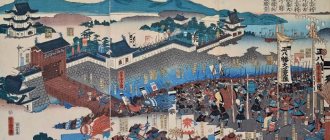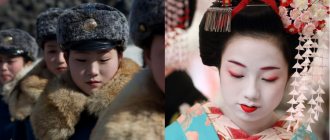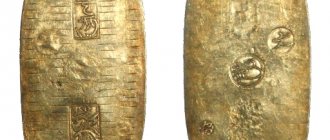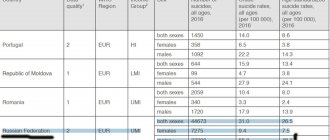Prerequisites for Japan's entry into the war
The Asian expansion of Japan caused serious concerns in Great Britain. Foreign Minister E. Gray was afraid that Japan, by participating in the war, would excessively expand its possessions. Despite the protests of the Admiralty, he prevented Japan from entering the war. On August 1, 1914, Gray informed his Japanese colleague Kato that Great Britain required assistance only in the event of an attack on the Far Eastern colonies.
Help with student work on Japan in World War I
Coursework 410 ₽ Essay 250 ₽ Test paper 230 ₽
Get completed work or consultation with a specialist on your educational project Find out the cost
However, Winston Churchill had a different view. Due to the concentration of British dreadnoughts in Europe, only old ships remained in the Pacific Ocean. Defending this position, Churchill, speaking in the House of Commons in March 1914, said that the defeat of the British fleet in the Atlantic would render the squadron helpless in the Pacific. This policy increased Britain's dependence on its allies. France took responsibility for the Mediterranean, and Japan had to protect the Chinese seas. On August 11, 1914, Churchill told Gray that he feared that Anglo-Japanese relations would collapse as a result of his hostile actions. Churchill's speech changed Gray's position.
On August 15, 1914, the Japanese government presented an ultimatum to Germany, demanding the withdrawal of German troops from the Pacific. Having received no response, Japan declared war on the German Empire on August 23, 1914. On August 25, Japan declared war on Austria-Hungary. Japan's performance on the side of the Entente gave Russia the opportunity to transfer Siberian corps to the west. Japan also became a source of supplying Russia with weapons and raw materials.
Looking for ideas for study work on this subject? Ask a question to the teacher and get an answer in 15 minutes! Ask a Question
Background [edit]
Further information: Anglo-Japanese Alliance
During the second half of the 19th century, Japan dramatically transformed from an almost completely closed society into a modern industrial, imperial, and militarily aggressive nation. He captured colonies such as Okinawa, defeated China in a great war (1894-1895), and, to the surprise of the world, defeated Russia in a full-scale war in 1904-05. He made aggressive demands, took full control of Korea (1910), expanded into Manchuria, and demanded special privileges in the Chinese economy. [12]
A 1909 cartoon in the American magazine
Puck
shows (clockwise from the far right cartoon) the United States, Germany, Great Britain, France, and Japan engaged in a sea race in a "no holds barred" game.
Both Japan and Britain avoided military alliances until 1900. The situation changed in 1902 with the signing of the Treaty. This diplomatic milestone ended Britain's splendid isolation and removed the need for Britain to build up its fleet in the Pacific. The alliance was renewed and expanded twice, in 1905 and 1911. The original goal was to counter Russian expansion. The alliance facilitated Japan's entry into World War I, but did not require Japan to do so. [3] Britain did not consult Japan before declaring war on Germany, but soon after the war began it asked Japan for help in locating German ships, which it admitted was not neutral. Japan decided that for its own prestige in world affairs it must join the war. The European Allies officially granted Japan full ally status, and Britain, France, Russia, and Italy guaranteed support at the proposed peace conference for Japan's claims to seize Germany's holdings in China. However, Britain became increasingly irritated by Japanese aggression and quietly warned that Japan should not occupy the German islands in the South Pacific (which Australia and New Zealand wanted), should not become involved in the Eastern Pacific, and should not take over the Dutch East. India. [4] When Japan ignored the hints, Britain made them public, and Tokyo felt insulted. [ citation needed
] Japan entered the war without restrictions, but in practice it seized German possessions in China, the German islands north of the equator, and seriously threatened Chinese autonomy, the 21st Demand of 1915. China, under very strong pressure from Tokyo and with broad support from all the other allies, decided in 1917 that it too should enter the war. [5]
The British did not like Tokyo at all, and received even stronger complaints from Washington and Australia. The Paris Peace Conference (1919–1920) did approve of Japan gaining League mandates over several former German possessions. But Japan went much further and demanded that the covenant of the proposed League of Nations include a clause declaring the organization's commitment to racial equality. Great Britain and her Dominions voted against it, as did the United States; the proposal never went through, and the insult plagued him for years. Finally, the Japanese intervention in Siberia (1918-1922), while parallel interventions by Britain, France and the United States seemed too much of a land grab. By 1907 Japan had come to détente with Russia, but the 1917 collapse of the Russian Imperial Government meant that Siberia seemed wide open. Japan wanted to extend the main treaty with Great Britain, but increasingly vocal objections came from the British Dominions, the United States, China, and Great Britain itself. The diplomatic solution was to end extension negotiations and have all major players approve the 1921-1922 Washington Naval Conference agreement on naval force limitations. To the disappointment of the Japanese, the treaty with Britain expired in 1923. Now Tokyo had neither allies nor real friends. [6] [7]
1914 Campaign
Note 1
On August 16, an order was published in Japan on mobilization and preparation for an operation against the German base of Qingdao.
In accordance with agreements between England, France and Japan, the Japanese fleet provided security north of Shanghai. The disposition of the Japanese fleet was established:
- The Japanese 1st Squadron cruised in the area north of Shanghai to cover the sea routes;
- 2nd squadron - fought against Qingdao;
- 3rd Squadron - provided protection for the area between Shanghai and Hong Kong;
- The cruisers "Ibuki" and "Tikuma" as part of the English squadron participated in the search for Admiral Spee in the German squadron.
The operation in Qingdao was carried out by Japanese troops with the symbolic participation of a British battalion. On September 2, the Japanese began landing on the Shandong Peninsula in China; On September 27, the attack on German positions began; On October 17, the important mountain “Prince Henry” was taken, on which an observation post was established. The bombardment of the forts began on November 5. The Germans, having sunk all the ships, capitulated on November 7. During the siege, the Japanese used naval aviation against ground targets for the first time.
At the same time, the ships of the 1st squadron participated in the search for von Spee's squadron. The battlecruiser Kongo controlled communications passing through the Midduech area. The armored cruiser Izumo was ordered to guard allied shipping off the coast of America. The armored cruiser Ibuki and the light cruiser Chikuma were sent to Singapore to strengthen the Allied fleet in Southeast Asia. The battleship Satsuma and the cruisers Yahagi and Hirado patrolled the sea lanes leading to Australia. The Japanese also provided transportation for French troops from Indochina.
On November 1, 1914, the Japanese, at the request of the British, introduced patrols east of the 90th meridian. After the arrival of the German gunboat Geyer in Honolulu, the cruiser Asama and the battleship Hizen approached the port and remained there until the Geyer was interned by American authorities on November 7.
Despite the alliance, a race developed between Japan, Australia and New Zealand to take over the German colonies in the Pacific Ocean. On September 12, Japan occupied the Caroline and Mariana Islands, and on September 29, the Marshall Islands. On October 1, a Japanese squadron captured the German port of Rabaul on the island of New Britain. New Zealand troops managed to occupy Samoa under the very nose of the Japanese.
By the end of 1914, the British and Japanese governments settled the issue of annexation of German possessions. To avoid incidents, the British agreed not to operate north of the equator.
1915 Campaign
The war in the European theater dragged on, and Japan gained freedom of action in the Far East. In January 1915, Japan sent "Twenty-One Demands" to Chinese President Yuan Shikai. China could not provide effective resistance to Japan, and the ultimatum was accepted by the Chinese government.
In February 1915, Japanese marines took part in suppressing the mutiny of Indian units in Singapore.
The Japanese fleet assisted in the search for the German cruiser Dresden and guarded the American port of Manila so that German ships would not use it. For a year, Japanese ships patrolled the coast of the Dutch East Indies and the South China Sea.
1917 campaign
In January 1917, the Japanese government demanded a British commitment to hand over the German holdings in Shandong at a post-war conference. In mid-February, Japan received corresponding secret commitments from its allies. This agreement was not known to the United States until the Versailles Conference.
In February 1917, the Japanese agreed to extend their patrol area to the Cape of Good Hope. The Japanese fleet became involved in the defense of shipping off the coasts of New Zealand and Australia.
On March 11, the first Japanese ships set sail for the European theater. Although the arrival of 1 cruiser and 8 destroyers could not change the situation in the Mediterranean, the Japanese received an important task - to escort troop transports with reinforcements to France.
Results[edit]
Main article: Japan during World War I
Japan's participation in World War I on the Allied side sparked unprecedented economic growth and brought Japan new colonies in the South Pacific captured from Germany. [15] After the war, Japan signed the Treaty of Versailles and enjoyed good international relations through membership in the League of Nations and participation in international disarmament conferences. However, he was outraged by the sense of racial superiority of the white powers. [16] The Japanese army became an increasingly independent political force with its own plans for how to deal with Manchuria, China, and Russia, independent of civilian decision-makers. [17]
1918 Campaign
During the German spring offensive, the British needed to transfer troops from the Middle East across the Mediterranean to Marseille. Japanese ships helped transport 100,000 British troops. After the crisis ended, Japanese ships provided transport of troops from Egypt to Thessaloniki.
Results of the war for Japan.
Japan benefited from the fact that the attention of its competitors - the USA and England, Russia, Germany, France - was diverted from the Far East by events in Europe. Japan seized German “leased territories” in China and island possessions in the Pacific Ocean, and also monopolized Far Eastern markets during the war years.
Do you need to select scientific articles for your academic work? Specify a topic and receive a response in 15 minutes get help
Japan during the First World War. Defensive alliance with Russia
Details Category: Workshop of historians Published: January 15, 2019
During the First World War, Japan avoided participation in prolonged hostilities on land, but managed to transform itself from a leading Far Eastern power into a great world power.
It is no coincidence that the first decades of the 20th century are called the “golden age of Japanese diplomacy” by official Japanese historiography. During the First World War, there was a significant adjustment in Japanese foreign policy. Remaining formally faithful to the allied relations with Great Britain, the Mikado empire moved towards rapprochement with Russia, culminating in the signing of an alliance treaty in the summer of 1916. This defensive alliance to this day is the apogee of interstate contacts between our countries. Neither before nor after have Russia and Japan had closer, more productive and trusting relations.
But the path to this union turned out to be difficult. The Treaty of Portsmouth of 1905 summed up the results of the Russo-Japanese War; treaties of 1907, 1910 and 1912 divided the spheres of influence of Japan and Russia in Manchuria and Inner Mongolia. All this time, the military leaders of both countries continued to fear an armed attack from the opposite side. In 1905–1914, the climate of Russian-Japanese relations was still tinged with mutual distrust. The state of the Russian armed forces forced the Russian command to doubt the possibility for Russia to successfully wage not only an offensive, but also a defensive war in the Far East.
The mood in the political spheres was different. For some representatives of the elite, aimed at continuing Russia's activity, establishing good neighborly relations with Japan was valuable in itself; for others, supporters of moving the vector of Russian activity to the West, such a course was a condition for Russia to solve its “historical tasks” in the traditional – European and Balkan – theaters.
The World War only strengthened such sentiments. For the Russian government, a powerful impulse to establish friendly and then allied relations with Japan was the need to secure its Far Eastern rear, to “squeeze” Germany out of China as the main military enemy, to ensure the inviolability of its interests agreed with Tokyo in China and Mongolia, and finally, the urgent need Russia in weapons, ammunition, military materials and loans.
Japan was pushed towards rapprochement with Russia by the logic of the course taken at the end of the 19th century to expand its presence in mainland Asia. Tokyo sought to take advantage of the current political situation. The outbreak of the World War and the dependence of the Russian army on supplies from outside made Petrograd more flexible in solving Far Eastern problems. Strategically, the establishment of allied relations with Russia was also important to prevent the probable, as it seemed to Tokyo analysts, emergence in the post-war world of an alliance of “white” great powers that was potentially dangerous for Japanese interests. As a result, already in the first weeks of the World War, the mutual readiness of Japan and Russia to move towards each other became obvious. The unexpected initiator of this rapprochement in the field of military supplies was official Tokyo.
Subsequently, Japanese-Russian interaction developed in a variety of areas. The driving force and core of this interaction was Japan's military supplies to its northern neighbor. Trade transactions of this kind were unprecedented in the history of relations between the two countries. Any important Russian-Japanese political or fiscal document of the war years took into account Japan's sale to the Russian army and navy of small arms, artillery, ships, ammunition, equipment, ammunition, military materials, and medicines.
Already at the turn of 1914–1915, multimillion-dollar purchases were made in Japan by six main departments of the Russian Military Ministry - the General Staff, artillery, quartermaster, military-technical, military sanitary and air force. Japan carried out large orders from the Russian Navy Department, the Red Cross, the Central Military-Industrial Committee, the Chief Commissioner for the Supply of Metals, the Ministries of Trade and Industry, Railways, Agriculture, and Finance. The “Metal Committee” and civil ministries purchased metals, coal mining equipment, port cranes, dredgers, steam locomotives, and medicines here; The Ministry of Finance ordered the minting of Russian silver coins at the Osaka Mint in the amount of 22.5 million rubles.
Exchanges of delegations gave special confidence to Russian-Japanese relations. In January 1916, a delegation headed by Grand Duke George Mikhailovich went to Tokyo. This trip was the first congratulations to the new Emperor Yoshihito (Taisho) on his coronation from a European monarch and the first (but, alas, last) visit to Japan by a representative of the Russian imperial house after the Russo-Japanese War of 1904–1905. The answer was the arrival in Russia in September of the same year of the emperor’s cousin, Prince Kanin. Shortly before him, a representative delegation of the upper house of the Japanese parliament visited Russia, and throughout the war - dozens of representatives of the Japanese ground and naval forces, figures from the financial and credit world, trade and industry. In the center of Petrograd, a Japanese Red Cross infirmary with Japanese personnel was deployed.
Private and public donations flowed from Tokyo to Russia. The Kuhara mining company, founded in Osaka in 1912 and which became rich from military supplies to Russia, in 1915 transferred 100 thousand rubles to Petrograd in favor of Russian wounded soldiers and their families, for which they received royal gratitude. The Society for Aid to Injured Allied Soldiers, founded in January 1917, had collected 2 million yen in donations by the middle of that year. Among the largest donors were the Chairman of the Society, Prince Tokugawa Iesato, Vice-Chairman Shimada Saburo, Baron Shibusawa and other representatives of the Japanese nobility and ruling circles.
Ordinary Japanese did not remain indifferent to the Russian-Japanese rapprochement. In the winter of 1914–1915, the Kokumin newspaper organized an all-Japan children's drawing competition on the theme of Russian-Japanese friendship. From the several thousand drawings received, the newspaper's editors selected 800 of the most successful ones. They compiled four albums, which Japanese journalists presented to the head of the delegation of the Main Artillery Directorate, General Hermonius, to present to the heir to the Russian throne. In January 1916, the Russian vice-consul in Korean Fuzan (Busan) received a collective letter from 106 workers at the Osaka arsenal. Japanese craftsmen, out of a sense of allied duty, expressed a desire to work in Russian arms factories - for the same remuneration as at home, day and night, and without even claiming reimbursement of travel expenses.
During the war years, Japan sold and supplied the Russian army, navy and military industry with a total of at least 820 thousand rifles and carbines, several hundred million cartridges for them, more than 1,100 guns of various calibers with millions of shells, hundreds of thousands of pounds of gunpowder, thousands tons of sulfur, camphor, brass, copper, millions of arshins of military cloth and pairs of shoes, other quartermaster, military-technical and military-sanitary property. Japanese supplies of rifles and guns amounted to a third and a fifth of the corresponding weapons purchased and received by Russia from abroad during the war (about 2.5 million rifles and 5,625 guns). Unlike other foreign suppliers, the Japanese fulfilled Russian orders strictly on time and with high quality (but not price). The Japanese government sold its rifles to Russia at half the price of, say, the United States. During the war, every tenth rifle in the Russian army and every third in the navy was Japanese.
During the war years, Japan significantly strengthened its international position. In 1915, by putting its signature on the London (1914) Declaration of the Entente, official Tokyo ensured its full participation in peace negotiations following the war. The next steps towards the Mikado Empire gaining the status of a great power were the conclusion of treaties with Russia in 1916 and with the United States in 1917. The Russo-Japanese Treaty was mutually beneficial, but had different “weight” for the signatory countries. With its help, Russia solved a number of primarily tactical problems. In exchange for a promise of compensation to the Japanese side, Petrograd received from Tokyo confirmation of its exclusive interests in northern China, additional guarantees of the security of its own Far Eastern territories and Tokyo’s non-conclusion of a separate peace with Germany. The very fact of such an alliance implied the continuation of Japanese military supplies, vital to the Russian active army, and the provision of multimillion-dollar loans to Russia for placing defense orders in Japan. These circumstances were of value only for the duration of the war and were exhausted after the Bolshevik government left it in the spring of 1918. The Kremlin's refusal to fulfill the international obligations of the tsarist government invalidated the articles of the alliance treaty with Japan.
Having purchased weapons, defense-related materials and goods worth over 400 million yen from Japan, Russia emerged from the war with a debt to this country of more than 240 million yen. Moreover, in 1915–1917, in the form of collateral for debt to allied countries, including Japan, a total of 286 million rubles worth of yellow metal, or approximately a fifth of the Russian gold reserves, were exported from Vladivostok on Japanese military ships. Formally, the gold was exported temporarily, but it was never returned to Russia.
For Japan, the 1916-1917 conventions with Russia and the United States played both a tactical and strategic role, providing it with the conditions for pursuing an independent policy in China and, albeit for a short time, double security guarantees - simultaneously with Great Britain and Russia. With the same treaty and a subsequent agreement with the United States, it completed a series of agreements with great powers to recognize their “special interests” in continental Asia. The logic of expanding its influence in the Asia-Pacific region also included Tokyo’s refusal to send its regular ground forces to Europe - contrary to the persistent wishes of its allies, especially France.
Supplies to Russia gave a serious impetus to the development of Japanese industry and significantly improved its export-import balance and overall financial and economic condition. In the Japanese press about. The foreign trade balance of this country became positive, remaining so throughout the world war, and the gold reserves increased fivefold, almost equaling the gold reserves of the Russian Empire.
The socio-political climate also changed: during the First World War, the image of a “treacherous and bloodthirsty Russian barbarian” was replaced by the image of a Russian as sincere, sincerely disposed towards Japan and spiritually close. The Japanese elite set a course for strengthening ties with Russia along all “lines,” and business hatched plans to expand its presence in the Russian market. The coming to power of the Bolsheviks dashed these hopes...
In the early 1920s, a Russian diplomat noticed how the Japanese people, “who had increased their well-being during the war, became more and more Europeanized,” but along with the rapid development of the economy, Japan experienced inflation and worsening social problems. The country was shaken by mass protests, and these years - let me remind you, regarded as the “golden age of Japanese diplomacy” - from the point of view of the internal situation, turned into an “era of popular anger.”
Sources:
- Kajima M. The Emergence of Japan as a World Power, 1895–1925. Rutland-Tokyo, 1968. P. 9.
- See: Shulatov Ya.A. On the way to cooperation: Russian-Japanese relations in 1905–1914. Khabarovsk-M., 2008.
- See: Pavlov D.B. Russian-Japanese relations during the First World War. M., 2014. P. 12-45
- RGVIA. F. 2000. Op. 1. D. 7931. L. 1. – Review of the state of the economy and finances of Japan, prepared for the GUGSH by the headquarters of the Amur Military District. 1917
- See: Abrikosov D.I. The fate of a Russian diplomat/trans. from English M., 2008. P.360-361.
Dmitry Pavlov Doctor of Historical Sciences, Deputy Director of the IRI RAS
